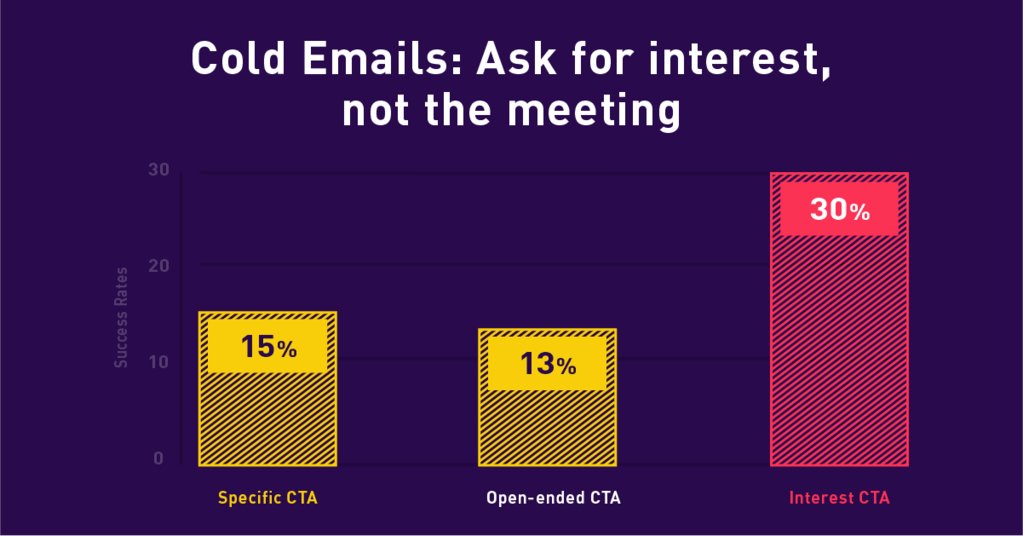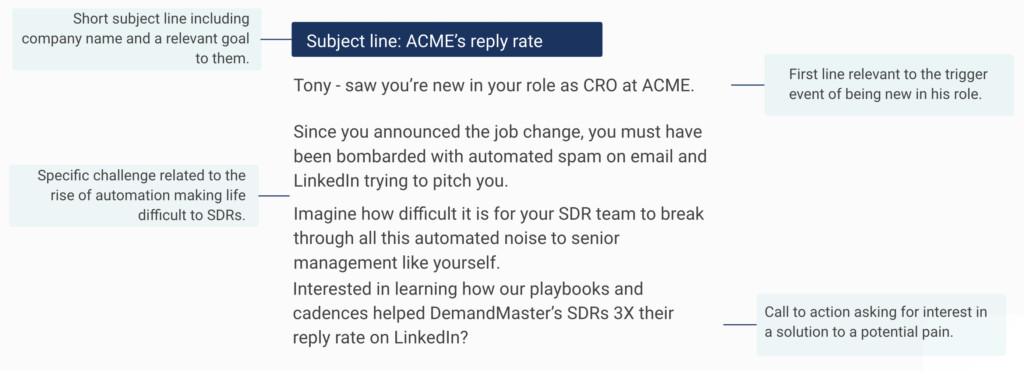Outbound sales emails are a lot like cold calls: you’re reaching out to a prospective customer who has never heard from your organization.
Or perhaps they know about your company, but have no previous relationship with you.
So when your cold email hits the prospect’s flooded inbox, you better nail it so you don’t end up in the junk folder.
In this post, I will show you how to write a sales email that actually converts. These tips have not only worked for us at Growth Genie, but for many of the sales teams we’ve worked with.
And it all begins with the subject line.
Irresistible Email Subject Lines
Without a compelling subject line, nothing else matters – you need prospects to first open the email to read your message or your sales pitch.
So it must stand out and cause curiosity.
One of the first things you have to do is personalize the subject line, starting with the name of the person or company name.
For instance, one of our clients saw their open rate increase by 15% when they included the recipient’s first name in the subject line.
Subject lines should be 4 words or under and include something relevant to the recipient. Be as specific as possible, even using a particular pain point in the subject line.
Some great examples of personalized subject lines are:
- Sarah, low conversions
- Mike, security
- Amir, reporting challenges
How to write an effective sales email
Outbound emails may be cold, but don’t have to be dead. Use the CPR rule to resurrect your cold outreach.
CPR stands for Clear, Personal, and Relevant.
Clear. Don’t use vague, generic language. The following terms are jargon and make you sound like everyone else: Efficiencies, Automate process, Optimize, Circling Back.
Personal. The more personalized, the better. Besides their name and company, you can reference their industry, competitors, mention unique situations they’re facing, reference a real (relevant) use case of your product by a similar company, and offer specific solutions to their problems.
Relevant. Put yourself in your buyer’s shoes. If you had their job title and worked in their industry and that their company specifically, would it get your attention.
How long should a sales email be?
In cold outbound, email length is important as recipients will do a quick scan of your email as they receive hundreds of emails a day. So, keep your emails under 100 words.
What about the Call-To-Action?
You should always include at least one call to action in every sales email.
Ask yourself, what is the one thing you want the prospect to do when they read your email?
Most salespeople today ask for a meeting. But that’s what everyone else does and standing out is one of the key parts of an outbound email.
Gong analyzed the CTAs of 304,174 emails to see which ones resulted in a meeting booked in the following 10 days.
They grouped CTAs into three categories:
- Specific CTA: Are you available to meet Monday at 11am?
- Open-ended CTA: Are you available sometime next week?
- Interest CTA: Are interested in learning more?
They found that the best CTA for cold emails is interest (See image below).

Do you want to learn how to ask for interest? No problem. In the next section, we’ll look at an example of a sales email with an Interest CTA.
Outbound Sales Email Templates
A key to success with your email sequences is to offer real value. Most cold emails go for the meeting or the sale without offering value or establishing trust.
One great way to offer value is identifying a pain point your prospect might have and offering a free resource (a related article, report, video, podcast, etc.) that would help solve that problem.
Ask yourself: What can I give away for free that will interest my buyer? Something that’s not my product or service but that is related to what I’m selling. Think of this first email as a soft sell.
The content giveaway email can work well as a first touch as it relates to the rule of reciprocity: people are more likely to give you their time once you have offered them something of value first.
Let’s look at this email template:

Notice the structure of the example above.
- The opening line is a trigger event, your reason for contacting the prospect. In this example, the trigger event is that they’re hiring SDRs, but it can also be the opening of a new location, an award they received, noticing they use certain software, or even a social media post or blog article that they have written.
- The second line is a challenge associated with that trigger event. In our cold sales email example we mention a specific challenge or pain point: the time it takes a new SDR to be fully productive.
- Finally, the call to action is asking for interest in a piece of content that can help them solve the problem. In this case, the content giveaway is a Playbook Template that can help them ramp up SDRs quicker. You are making a promise to cut the time in half, which should pique their interest.
What if you don’t get a response? A lot of the time, people may not reply to your initial email not because they are not interested but because they are:
- Out of office
- They opened the email and were interested but did not have time to reply
- Busy with internal matters
That’s when you send a follow up bump email with just one line – asking again for interest in the benefit of the previous email.

Now, let’s look at a second sales email template, using a more direct approach. Instead of a content giveaway, you’ll use a customer story.
The model is: “Are you interested in learning how we helped another company achieve X result?”
Here’s an example:

In this example we asked if they were interested in learning how we helped another company increase their reply rate on LinkedIn,
Notice that the formula is the same. We open with a trigger event (why are you being contacted), follow that with the pain point and end with a call to action (are you interested in a solution?).
Again, here’s the follow up email we would send for this second example:

Building an Email Sales Cadence
Your prospects won’t always book a meeting or respond after a couple of emails. Even if you have written the perfect sales email, you still need to step up your follow up game with a sales cadence.
At Growth Genie, we have created The Ultimate Outbound Sales Cadence, which combines automation and personalization to increase your chances of success during the sales process.